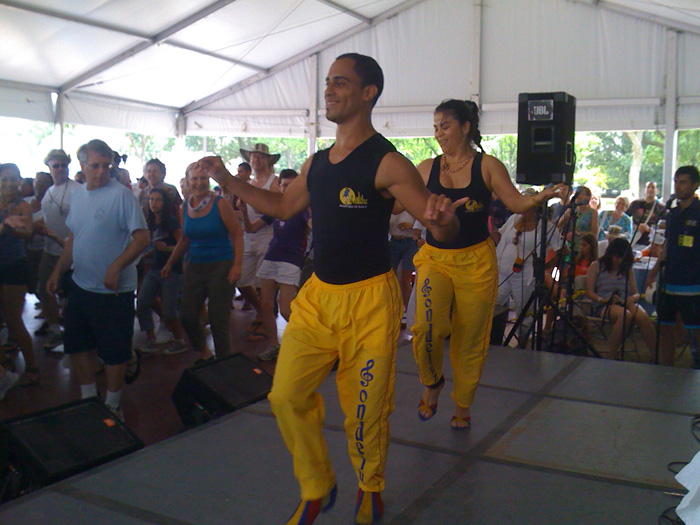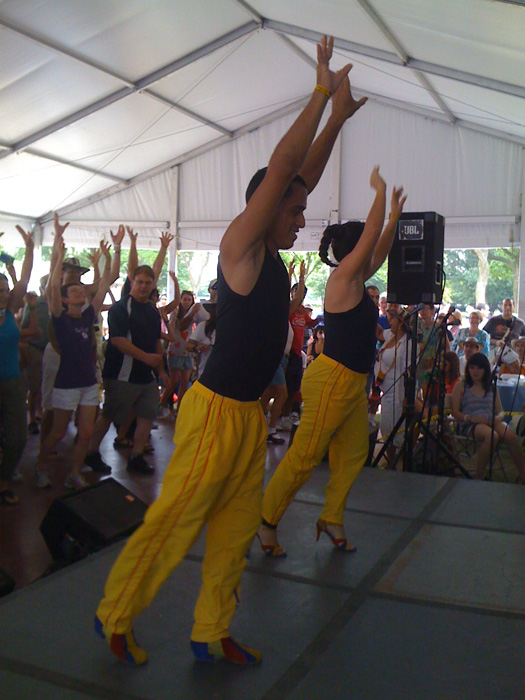Learn the Salsa Caleña: Movements and Rhythms of Colombia
On El Rumbiadero Stage at the Smithsonian Folklife Festival, in front of over 200 spectators and eager participants, stood Luz Aydé Moncayo Giraldo and Deyvi Johan Zúñiga Jiménez. Wearing outfits adorned with the colors of the Colombian flag, they clapped to the beat of the music that resounded across the area, inviting the participants to catch rhythm with their hands, to begin immersing themselves into the music and movement of Salsa Caleña.
Known for strong beats and sensuous rhythms, salsa music can consist of a host of instrumentation, from trumpets, trombones, saxophones, guitars, pianos, with the most important part of the music coming from the percussion instruments: claves, cowbells, timbales, and congas, which set the timing for the music and the dance. Originally, a mix of Latino musical traditions, salsa draws primarily from Afro-Cuban and Puerto Rican influences that coalesced in the urban landscape of New York and later disseminated across Latin America and regionalized. The diversity inherent in salsa is often attributed as being the source of the name; salsa, because it is a mix of many different rhythmic flavors with an energy that is hot and spicy.
Salsa Caleña is from Cali, Colombia, the hometown of Luz and Deyvi, often referred to as the Capital de la Salsa (Salsa Capital), due to the presence of salsa as the dominant musical form in parties, nightclubs, and festivals. It is differentiated from other types of salsa because of the strong focus on Colombian rhythms, particularly cumbia and boogaloo. Luz and Deyvi introduced the crowd to this dance form by demonstrating three different 8-count steps, with the pause on the 4 and the 8: 1-2-3-*-5-6-7-*. Each step begins in a standing position, with the feet shoulder width apart, back straight, and the weight situated on the right foot.
For 45 minutes, Luz and Deyvi electrified the audience, taking them from practicing basic footwork, to throwing in upper-body stylizations, having them swing their arms into position and shimmy their torsos with the music. By the end of it, the crowd and performers were exhausted but smiling, and Luz applauded the participants for their berraquera, tenacity in practicing this dance form.
Click on the image below to enlarge and view the gallery

-
Photo by Eric Cesar Morales
-
Photo by Eric Cesar Morales
-
Photo by Eric Cesar Morales
Basic Salsa Step
- Count 1: Left foot steps forward; right heel is raised off the ground.
- Count 2: Transfer weight to the right foot.
- Count 3: Left foot is moved back in place next to the right foot.
- Count 4: Pause
- Count 5: Right foot steps backward; Left foot is raised slightly.
- Count 6: Transfer weight to the left foot.
- Count 7: Right foot is moved back in place next to the left foot.
- Count 8: Pause Sidestep
- Count 1: Left foot steps to the left; right heel is raised and lifted slightly off the ground.
- Count 2: Transfer weight to the right foot.
- Count 3: Left foot is moved back in place next to the right foot.
- Count 4: Pause
- Count 5: Right foot steps to the right; left heel is raised and lifted slightly off the ground.
- Count 6: Transfer weight to the right foot.
- Count 7: Left foot is moved back in place next to the right foot.
- Count 8: Pause
- Count 1: Left foot kicks forward on the left diagonal and quickly steps backward on the right diagonal; right foot is raised off the ground while the left foot steps back.
- Count 2: Transfer weight to the right foot.
- Count 3: Left foot moves forward, and the feet are again shoulder width apart.
- Count 4: Pause
- Count 5: Right foot kicks forward on the right diagonal and quickly steps backward on the left diagonal; left foot is raised off the ground while the right foot steps back.
- Count 6: Transfer weight to the left foot.
- Count 7: Right foot moves forward, and the feet are again shoulder width apart.
- Count 8: Pause
- Atras (Diagonal Step)



